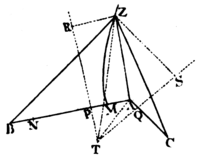vh and ab are equal. But becauſe of the ſimilar triangles VSH, vsh, VH is to SH as vh to sh; that is, the axe of the conic ſection now deſcribed is to the diſtance of its foci, as the axe ab to the diſtance of the foci s, h; and therefore the figure now deſcribed is ſimilar to the figure aph. But, becauſe the triangle PSH is ſimilar to the triangle psh, this figure paſſes through the point P, and becauſe VH is equal to its axis, and VS is perpendicularly biſected by the right line TR, the ſaid figure touches the right line TR. Q. E. F.
Lemma XVI.
From three given point: to draw to a fourth point that is not given three right lines whoſe differences ſhall be either given or none at all.

Case 1.. Let the given points be A, B, C (Pl. 8. Fig. 1.) and Z the fourth point which we are to find; becauſe of the given difference of the lines AZ, BZ, the locus of the point Z will be an hyperbola. whoſe foci are A and B, and whoſe principal axe is the given difference. Let that axe be MMN. Taking PM to MA, as MN is to AB, erect PR perpendicular to AB, and let all ZR perpendicular to PR; then, from the nature of the hyperbola, ZR will be to AZ as MN is to AB. And by the like argument, the locus of the point Z will be another hyperbola, whoſe foci are A, C, and whoſe principal axe is the difference between AZ and CZ; and QS a perpendicular on AC may be drawm to which (QS) if from any point Z of this hyperbola
